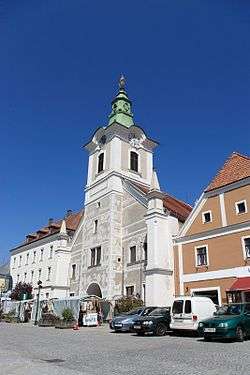Zwettl
| Zwettl | ||
|---|---|---|
 | ||
| ||
 Zwettl Location within Austria | ||
| Coordinates: 48°36′12″N 15°10′08″E / 48.60333°N 15.16889°ECoordinates: 48°36′12″N 15°10′08″E / 48.60333°N 15.16889°E | ||
| Country | Austria | |
| State | Lower Austria | |
| District | Zwettl | |
| Government | ||
| • Mayor | Herbert Prinz (ÖVP) | |
| Area | ||
| • Total | 256.07 km2 (98.87 sq mi) | |
| Elevation | 520 m (1,710 ft) | |
| Population (1 January 2016)[1] | ||
| • Total | 11,005 | |
| • Density | 43/km2 (110/sq mi) | |
| Time zone | CET (UTC+1) | |
| • Summer (DST) | CEST (UTC+2) | |
| Postal code | 3910 | |
| Area code | 02822 | |
| Vehicle registration | ZT | |
| Website | www.zwettl.gv.at | |
Zwettl is a town and district capital of the Austrian state of Lower Austria. It is chiefly known as the location of Zwettl Abbey, first mentioned in October 1139.
Geography
Zwettl has a total area of 98.9 square miles (256.7 km²). The town is found in the middle of Waldviertel at the confluence of the Kamp and Zwettl rivers. After Vienna and Wolfsberg in Carinthia, it is the third largest municipality in Austria by area.
Population
| Historical population | ||
|---|---|---|
| Year | Pop. | ±% |
| 1869 | 12,643 | — |
| 1880 | 13,121 | +3.8% |
| 1890 | 12,961 | −1.2% |
| 1900 | 13,617 | +5.1% |
| 1910 | 13,585 | −0.2% |
| 1923 | 12,946 | −4.7% |
| 1934 | 12,746 | −1.5% |
| 1939 | 12,806 | +0.5% |
| 1951 | 12,862 | +0.4% |
| 1961 | 11,374 | −11.6% |
| 1971 | 11,677 | +2.7% |
| 1981 | 11,479 | −1.7% |
| 1991 | 11,427 | −0.5% |
| 2001 | 11,630 | +1.8% |
| 2011 | 11,272 | −3.1% |
History

The name originates from Slavic "svetla" meaning "glade". Although the etymology suggests an early population of Slavic people no archeological evidence has been found yet.[2] Zwettl was founded by the knights of Kuenring and was first mentioned in a monastery record in 1139. It was granted town privileges on December 28, 1200. Today, the Cistercian convent in Zwettl houses the only remaining manuscript of the life of the beguine mystic Agnes Blannbekin.
People
- (Johann) Michael von Puchberg (1741–1822), promoter and estate administrators of Mozart, merchant, philanthropist, born here
- Georg Ritter von Schönerer, (1842-1921), died here
- Hugo Jury, (1887-1945), physicician and National Socialist poltitician, lived here
- Benno Mengele (1898–1971), electrical engineer, born here
- Walter Nowotny, (1920-1944), Luftwaffe officer, lived here
- Peter Härtling, (born 1933), writer and poet, lived here
- Josef Haslinger (born 1955), writer, born here (de)
- Christoph Jank (born 1973), footballer
- Florian Metz, (born 1985), footballer, born here
- Andreas Haider-Maurer (born 1987), tennis player
References
- ↑ Statistik Austria - Bevölkerung zu Jahresbeginn 2002-2016 nach Gemeinden (Gebietsstand 1.1.2016) for Zwettl.
- ↑ "Der Name Zwettl" (in German). Municipal council of Zwettl. Retrieved 2009-02-18.
External links
![]() Media related to Zwettl at Wikimedia Commons
Media related to Zwettl at Wikimedia Commons
- Zwettl Town website (in German)
- Facts about Zwettl provided by the Austrian Statistical Central Office (in German)
